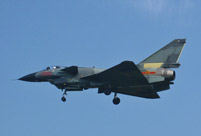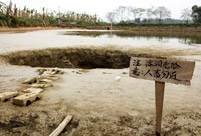

| In March, South African President Jacob Zuma toured the production facilities at the Transnet manufacturing plant in Koedoespoort, Pretoria, South Africa before watching the 95th electric locomotive roll off the production line. The locomotives are bought from China South Rail and built in SA with technology transfer. (Picture: People’s Daily Online / Zhang Jiexian) |
Despite the economic growth slowdown in emerging markets, strong demand from the Chinese market has brought business and prosperity to South Africa in 2015, highlighted by unprecedented wine and fruit exports to the oriental giant. According to SA Wine Industry Information & Systems, SA’s total wine export to China reached 11,848,894 litres from November 2014 to October 2015, recording an 85% year-on-year growth rate. For the first time, China has become one of SA’s top 10 wine export destinations. In contrast, SA’s 2015 GDP growth is anticipated by the International Monetary Fund to be about 2%.
In agribusiness, statistics from the Citrus Growers’ Association of Southern Africa (CGA) show that grapefruit export to China has doubled from 654,000 cartons in 2013 to 1,342,000 in September 2015. Valencia orange exports have increased from 1,120,000 cartons to 1,829,000 cartons so far this year. Although SA’s overall exports have declined 6.22% in the first six months, thanks to demand from the Chinese market citrus exports data have shown a defiant growth of 7%, according to SARS. Justin Chadwick, CEO of CGA, believes the increasing demand for southern hemisphere citrus is the result of Chinese consumers having more disposable income to spend on imported fruit.
Sub-Saharan Africa’s economic ties with China are inseparable. According to the statistics in 2014, the share of China-Africa trade in Africa’s total foreign trade increased from 3.82% to 20.5% in the past 15 years.
“Many friends expressed their concern over China’s economic performance,” wrote TianXuejun, Chinese Ambassador to SA in his opinion piece published on the IOL website. “President Xi Jinping vividly likened China’s economy to a huge ship sailing on the sea. Any ship, whatever its size, may occasionally experience unstable sailing.”
Tian explains: “China’s economy has entered a state of ‘new normal’ with accelerated transformation towards a higher end. China is not obsessively pursuing growth speed.”
According to Tian, the core concept and the strategic path of such a process is to promote transformation in five aspects, namely: realising innovation-oriented growth; intensive growth; consumption and investment driven economy; the decisive role of the market in resource allocation; and inclusive and shared economic benefits.
“The economic transformation of both China and Africa are highly complementary,” Tian affirms. “Both sides could offer each other opportunities, which will promise a new and broader space for future cooperation.”
International industrial cooperation will be the focus of China-Africa cooperation. Tian points out that the value of industrial output in the sub- Saharan region only accounts for 0.7% of the global total, while the manufacturing industry in most African countries contributes less than 15% to GDP.
“Although industrialisation is a weak point in Africa, economic transformation will be the engine for future development.”
Instead of simply exporting products, China will be exporting industries and skills “which will effectively help African countries to accelerate the building of a complete industrial system and manufacturing capability”, according to Tian.
In October, China pledged $50bn towards industrialisation projects in SA ahead of the summit of the Forum on China-Africa Cooperation in Johannesburg. The pledge was announced when Zhang Xiangchen, vice minister of commerce of China, visited SA earlier this year.
According to a Department of Trade and Industry statement, China will also provide 50 technical experts in the building and upgrading of industrial parks and new power plants, 40,000 training opportunities in different sectors and 200,000 industrial managers to train and develop local employees.
Earlier this year, China Africa Development Fund (CAD Fund), an equity investment fund which aims to diversify the financial vehicles that facilitate Chinese investment to Africa, announced that it will reach its full size of funding of $5bn in 2015.
So far, the fund has invested $2.3bn in 80 projects ranging from infrastructure, manufacturing, agriculture, power stations and power transmission to industrial zones in more than 30 African countries.
Shi Jiyang, CAD Fund President, said the fund will progressively invest in projects which have the potential to [spur] manufacturing growth.
“China will continue to uphold the principles of ‘sincerity, real results, affinity and good faith’ and support Africa’s economic transformation so as to achieve win-win results,” Tian concludes.
According to the statistics in 2014, trade between China and Africa exceeded $220bn and China’s investment stock in Africa surpassed $30bn, an increase of 22 and 60 times respectively over the figures in 2000.
(The story was originally published on Business Day on December 2nd, 2015.)
 The evolution of J-10 fighter
The evolution of J-10 fighter Top 10 Asian beauties in 2016
Top 10 Asian beauties in 2016 Train rides through blossoms
Train rides through blossoms North Sea Fleet conducts drill in West Pacific Ocean
North Sea Fleet conducts drill in West Pacific Ocean Breathtaking aerial photos of tulip blossoms in C China
Breathtaking aerial photos of tulip blossoms in C China Horrific: Pit swallows 25 tons of fish overnight
Horrific: Pit swallows 25 tons of fish overnight Police officers learn Wing Chun in E. China
Police officers learn Wing Chun in E. China Charming models compete in super model contest in Beijing
Charming models compete in super model contest in Beijing Beauties wearing Tang dynasty costume pick tea leaves
Beauties wearing Tang dynasty costume pick tea leaves Top 20 hottest women in the world in 2014
Top 20 hottest women in the world in 2014 Top 10 hardest languages to learn
Top 10 hardest languages to learn 10 Chinese female stars with most beautiful faces
10 Chinese female stars with most beautiful faces China’s Top 10 Unique Bridges, Highways and Roads
China’s Top 10 Unique Bridges, Highways and Roads My tiger mother controlled me with Chinese food
My tiger mother controlled me with Chinese food Shanghai court finds against maternity tourism company
Shanghai court finds against maternity tourism company Pranks under fire after video of celeb wedding shows actress harassment
Pranks under fire after video of celeb wedding shows actress harassment For foreigners, Chinese talent and reality shows offer a chance to hit it big
For foreigners, Chinese talent and reality shows offer a chance to hit it bigDay|Week